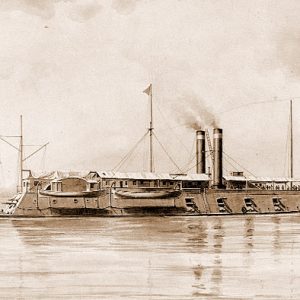calsfoundation@cals.org
William Talbot (1814–1899)
William Talbot was a sailor aboard the USS Louisville who received a Medal of Honor for his handling of the vessel’s nine-inch cannon during the 1863 Battle of Arkansas Post.
William Talbot (his Medal of Honor papers identify him as Talbott) was born in Liverpool, England, in 1814. At age sixteen, he immigrated to the United States, arriving at Bath, Maine, in August 1830. He got married on September 4, 1834, and he and his wife, Priscilla, would have five sons and a daughter. He became a naturalized citizen of the United States on July 7, 1848. In 1860, he was forty-six years old and worked as a rigger in West Bath, Sagadahoc County, Maine.
Talbot apparently enlisted in the U.S. Navy early in the Civil War and was serving in the western fleet aboard the ironclad gunboat USS Louisville by late 1862. That vessel was part of a powerful flotilla of naval vessels that accompanied a force of some 32,000 Union soldiers in an attack on the Confederate garrison at Arkansas Post. The ironclads led the attack on the Confederates manning the earthworks at Fort Hindman on the night of January 10, 1863. The Louisville, commanded by Lieutenant Commander Elias K. Owen, pounded the gun at the center of the fort, with Talbot serving as captain of the forecastle and commanding the vessel’s heavy nine-inch gun. “The fire was very destructive, killing nearly all the artillery horses in and about the fort,” Admiral David D. Porter reported. The vessels fell back for the night, with the Louisville having fired a dozen five-second shells and six ten-second shells from its nine-inch guns.
The gunboats attacked again on the morning of January 11, hammering Fort Hindman until, Porter reported, “all the guns in the fort were completely silenced.” The 4,900 Confederate defenders of Arkansas Post surrendered before the combined Union ground troops mounted a final assault, which was successful. Colonel John Dunnington, commanding the men of the CSS Pontchartrain who manned the heavy guns in Fort Hindman, personally surrendered to Admiral Porter, saying, “You wouldn’t have got us had it not been for your damned gunboats.” That day’s attack saw the Louisville fire seventy-eight five-second and twenty-eight ten-second shells from its nine-inch guns. The gunboat suffered three men killed or mortally wounded and eight wounded in the assault on Fort Hindman.
William Talbot was awarded a Medal of Honor through General Order No. 32, issued April 16, 1865, which noted his efforts as captain of the forecastle: “Carrying out his duties as captain of the 9-inch gun, Talbott was conspicuous for ability and bravery throughout the engagement with the enemy.”
Talbot returned to his work as a rigger in Bath after the war, but by around 1880 he was incapable of working because of “weak lungs.” He died on September 5, 1899, and is buried at Maple Grove Cemetery in Bath.
For additional information:
Bearss, Edwin C. “The Battle of the Post of Arkansas.” Arkansas Historical Quarterly 18 (Autumn 1959): 237–279.
Christ, Mark K. Civil War Arkansas, 1863: The Battle for a State. Norman: University of Oklahoma Press, 2010.
“CPT William R. Talbott [sic].” Findagrave.com. https://www.findagrave.com/cgi-bin/fg.cgi?page=gr&GRid=7256066 (accessed February 13, 2018).
Medal of Honor Recipients 1863–1978, Prepared for the Committee on Veterans Affairs United States Senate, February 14, 1979. Washington DC: Government Printing Office, 1979.
Smith, Myron J. Jr. Civil War Biographies from the Western Waters. Jefferson, NC: McFarland and Co., Inc., 2015.
Mark K. Christ
Little Rock, Arkansas
 Civil War through Reconstruction, 1861 through 1874
Civil War through Reconstruction, 1861 through 1874 Military
Military USS Louisville
USS Louisville 




Comments
No comments on this entry yet.